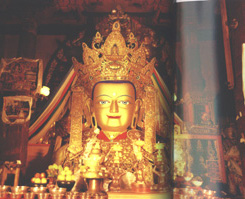 Drepung Monastery is actually a collection of Buddhist chapels and colleges located about 8km west of Lhasa. The word Drepung can be literally translated as "rice pile", a name whose meaning becomes clear when you see the white-walled buildings scattered along the hill. Originally founded in 1416, the monastery in its heyday was home to 10,000 monks (around 1600). In 1530, the second Dalai Lama built his palace here, known as the Ganden Palace, which was used until the fifth Dalai Lama built the Potala.
Drepung Monastery is actually a collection of Buddhist chapels and colleges located about 8km west of Lhasa. The word Drepung can be literally translated as "rice pile", a name whose meaning becomes clear when you see the white-walled buildings scattered along the hill. Originally founded in 1416, the monastery in its heyday was home to 10,000 monks (around 1600). In 1530, the second Dalai Lama built his palace here, known as the Ganden Palace, which was used until the fifth Dalai Lama built the Potala.
Besides the Ganden Palace, the Drepung Monastery buildings also include the tsogchen (the main hall). This is the most important structure of the Monastery. It contains several chapels, of special note are the Chapel to the Maitreya Buddha and chapels to local Tibetan protection goddesses known as Tara.
The Colleges of Drepang include the Ngagpa (focused on Tantric study), the Loseling (devoted to the study of logic and the largest of the colleges), and two other, lesser colleges. Monks are allowed to join a college based on their place of birth. This ages old "rule" gives each of the colleges a regional flair.
Of the architecture in the Zhaibung Monastery, the Coqen Hall and the Galdan Phobrang hold a very important position.
The Coqen Hall is the Grand Sutra Hall where monastery monks gather for rituals. The hall, lying at the center of the monastery, is propped up by 183 square wooden pillars and covers an area of l,850 square meters. It is large enough for 7,700 monks to recite sutras at the same time, which makes it the largest of its kind in the Tibetan areas in China. The hall porch is propped up by eight wooden pillars, and has 24 stone steps leading to a large square where monastery monks gather to debate on Buddhist doctrines.
In the northern part of the Coqen Hall is enshrined with statues of Buddha, with seats set up there specially for abbots, Living Buddhas, Geshi degree holders, leading sutra reciting masters and discipline lamas. In the middle of the hall are rows of 15-cm-thick cushions spreading dozensof meters from south to west. They bear color that matches kasayas worn by lamas.
The Coqen Hall is enshrined mainly with the statues of the Wisdom Buddha and the White Parasol Deity, as well as a two-story-high gilded statue of Qamba Buddha (in the Miwanglhakang at the center of the rear hall), and the statues of the Buddhist Trinity, Vajrapani and Diamond King with a Horse Head (in the Duisonglhakang to the left of the rear hall). Others inside the Coqen Hall are three gilded dagobas with niches for the Past, Present and Future Buddhas. In the rightsection of the rear hall are sutras. In the western section are rows of holy stupas and three silver dagobas. The middle row contains holy stupa for the 3rd Dalai Lama; the northern one contains the holy stupa for the 4th Dalai Lama; and the southern one contains the holy stupa for Chilai Gyamco.
The second floor of the Coqen Hall is divided into the eastern and southern sections. The southern section used to be the office for the chief bailiff of the monastery, while the eastern section, known as the Gangyurlhakang, houses valuable sutra books including Gangyur Tripitaka written in gold powder. The book, with l l4 volumes, was created by the Yunnan king during the Ming Dynasty in pray for peace. Other sutra books include wood-block Tripitaka in Tibetan of the Qing Emperor Kangxi period and pattra-leaf sutras.
On the And floor of the Coqen Hall are two major Buddha halls: Sutra Pavilion and Qamba Buddha Hall. Above the door to the Qamba Buddha Hall is a horizontal board, presented by Qing Dynasty High Commissioner Qi Shang in 1846. Inside the hall are enshrined with a giant statue of Qamba Buddha of the size of the Future Buddha when he was eight years old, a white conch legendarily believed to be discovered in the Gorba Mountain by Zongkapa who presented it to Qoigyai Zhaxi Bendain as an encouragement to him for building the monastery.
In the center of the fourth floor of the Coqen Hall is the Jorihakang enshrined with the statue of Sakyamuni lecturing on Buddhist doctrines and l3 silver dagobas flanking the statue. On the fourth floor is the Arhats Hall, where statues of various Buddhist masters, Arhats and major Living Buddhas with the Zhaibung Monastery are enshrined.
How to get there:Minibuses run from the area in front of Barkhor Square and will take you to either the base of the hill upon which Drepung sits or the parking lot on Drepung slopes. Drepung is also included in most of the "tours" from Lhasa. The fare is 3 yuan and the trip takes around a half an hour. The walk from the base of the hill to Drepung Monastery takes around another 30 minutes.
Opening hours: 9am - 4pm with varying lunch breaks at the different chapels and colleges at Drepung. Also many of the chapels and colleges close on Sunday.
(china.org.cn March 13, 2003)
|

